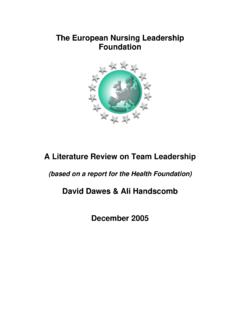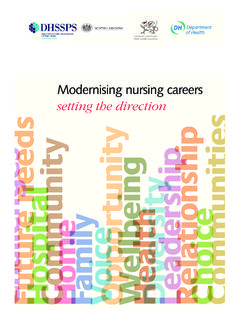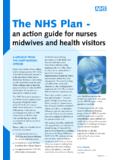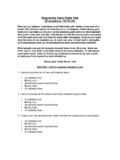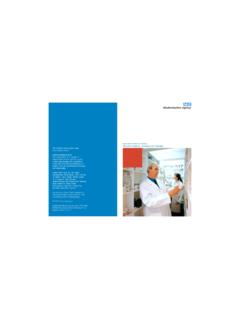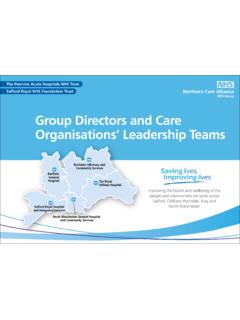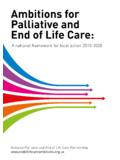Transcription of 10 High Impact Changes - Nursing Leadership
1 10 high Impact Changesfor Service Improvement and DeliveryA guide for NHS leadersDH INFORMATION READER BOXP olicyEstatesHR/WorkforcePerformanceManag ementIM&TPlanningFinanceClinicalPartners hip WorkingDocument PurposeBest Practice GuidelinesROCR Ref:Gateway Ref: 3483 Title10 high Impact Changes for service improvementand delivery: a guide for NHS leadersAuthorNHS Modernisation AgencyPublication DateSeptember 2004 Target AudiencePCT CEs, NHS Trust CEs, SHA CEs, Medical Directors, Directors of PH, Directors of Nursing , PCT PEC Chairs, NHS Trust Board Chairs, Directors of HR, Directors of Finance, Emergency Care LeadsCirculation ListDescriptionThe NHS Modernisation Agengy (MA), through work withthousands of clinical teams, has identified 10 high ImpactChanges.
2 This guide explains them with new ways of thinking about service improvement. It provides evidenceon local/national benefits through implementing thechanges. They have been included in the PPF guidelines asan evidence based approach to performance RefThere are many related MA guides/toolkits etc and these are referenced on the high Impact Changes DocsN/AAction requiredN/ATiming N/AContact DetailsMaggie Morgan-CookeAssociate Director, Innovation and Knowledge Group NHS Modernisation Agency4th FloorSt John s HouseEast StreetLeicester LE1 6 NBTel: 0116 222 5163E-mail: Recipient s Use3 ContentsChange No1.
3 15 Treat day surgery (rather than inpatient surgery) as the norm for elective surgeryChange No2:23 Improve patient flow across the whole NHS system by improving access to key diagnostic testsChange No3:31 Manage variation in patient discharge thereby reducing length of stayChange No4:39 Manage variation in the patient admission processChange No5:43 Avoid unnecessary follow-ups for patients and provide necessary follow-ups in the right care settingChange No6:51 Increase the reliability of performing therapeutic interventions through a Care Bundle approachChange No7:59 Apply a systematic approach to care for people with long-term conditionsChange No8:67 Improve patient access by reducing the number of queuesChange No9:75 Optimise patient flow through service bottlenecks using process templatesChange No10.
4 79 Redesign and extend roles in line with efficient patient pathways to attract and retain an effective workforce12345678910 Foreword 4 Highlights6 Introduction8 The 10 high Impact Changes15-84 Supporting implementation85 The role of the Board in supporting implementation86 Resources and tools89 Acknowledgements90 The NHS is changing for the times for treatment are falling. Newservices are being developed. Patients arebeing offered greater convenience andchoice. These improvements arehappening because NHS staff areactively engaged in re-shaping servicedelivery.
5 Between 2001 and 2004,over 150,000 NHS staff were involvedin the work of the NHS ModernisationAgency, making health services moreaccessible, safer and is further to go. We must aim forevery single patient to receive the bestpossible care, every single time. The 10 HighImpact Changes set out here can make atremendous contribution to reaching that Changes are the results of learning fromthe Modernisation Agency s work. They build onsuccesses already achieved. They are not theproducts of academic theory, or an isolatedgroup of supposed experts.
6 They are rooted ineveryday experience and the achievements ofthousands of frontline clinical teams, right acrossthe principles underpin this work. Firstly, the10 high Impact Changes are patient-centred we need to see the service through the patient seyes . Patients need us to provide care not asisolated episodes, but as a complete journey one which sometimes lasts for the rest of theirlives. Such care is not only physical: it isemotional, psychological and spiritual, andencompasses the needs of the whole , the Changes are evidence-based.
7 Weoften talk about evidence-based medicine: hereis evidence-based management! The 10 HighImpact Changes draw on the best availablelearning in how to make organisations workeffectively (whether in the public or privatesectors), both in the UK and overseas. They havebeen field-tested and evaluated in real life NHSsettings, and developed and adapted to have thebest chance of , the Changes imply a systems view of theworld. Healthcare is a complex process. A high quality service is only possible if everymember of the team and every part of thesystem is working effectively and in harmonywith the rest.
8 This means we need to look at thewhole picture valuing primary care, mentalhealth services and ambulances just as much asacute hospitals. We also need to recognise thetalents and contribution of all members of staff those in such support functions as laundry,catering, transport and management just asmuch as clinical Changes described here are an invaluablesource of ideas. However, identifying what ispossible is the easy part. The real challenges arein implementation. We know that life in the NHScan be pressurised, busy and often will only secure the potential benefitsdescribed here if we make a purposeful, directedleadership effort.
9 We need to help frontline staffto stand back and think about how to do thingsdifferently. We need the courage to break withingrained habits and practices. We need theenergy and perseverance to overcome theinevitable difficulties and obstacles. Above all, weneed an unwavering belief that it is possible tomake far-reaching improvements for those weserve patients, families, carers and hope that the ideas and examples we providehere are a help and inspiration in your FillinghamDirectorNHS Modernisation Agency31 August 2004 Foreword4 Foreword5We know thesechanges workand we havethe evidence to prove No1.
10 Treating day surgery (rather than inpatient surgery) as the norm for elective surgery could release nearlyhalf a million inpatient bed days each No2:Improving patient flow across the whole NHS byimproving access to key diagnostic tests could save 25million weeks of unnecessary patient waiting No3:Managing variation in patient discharge, therebyreducing length of stay, could release 10% of total bed days for other activity. change No4:Managing variation in the patient admission processcould cut the 70,000 operations cancelled each yearfor non-clinical reasons by 40%.
